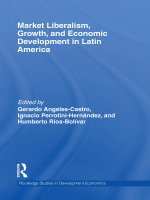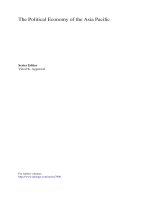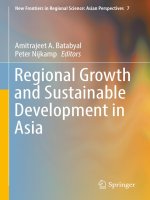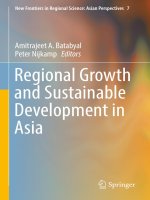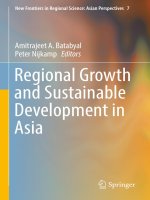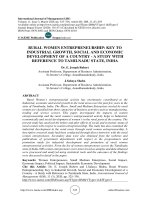Economic growth and economic development 155
Bạn đang xem bản rút gọn của tài liệu. Xem và tải ngay bản đầy đủ của tài liệu tại đây (109.81 KB, 1 trang )
Introduction to Modern Economic Growth
First, data on capital and labor shares across countries are not widely available. This makes the use of equation (3.27) far from straightforward. Consequently,
almost all calibration or levels-accounting exercises that estimate technology (productivity) differences use the Cobb-Douglas approach of the previous subsection
(i.e., a constant value of αK equal to 1/3).
Second, even if data on capital and labor shares were available, the differences
in factor proportions, e.g., differences in Kj /Hj , across countries are large. An
equation like (3.27) is a good approximation when we consider small (infinitesimal)
changes. As illustrated in Exercise 3.1, when differences in factor proportions are
significant between the two observations, the use of this type of equation can lead
to significant biases.
To sum up, the approach of calibrating productivity differences across countries
is a useful alternative to the regression analysis, but has to rely on a range of
stringent assumptions on the form of the production function and can also lead to
biased estimates of technology differences when factors are mismeasured.
3.6. Estimating Productivity Differences
In the previous section, productivity/technology differences are obtained as “residuals” from a calibration exercise, so we have to trust the functional form assumptions
used in this strategy. But if we are willing to trust the functional forms, we can
also estimate these differences econometrically rather than rely on calibration. The
great advantage of econometrics relative to calibration is that not only do we obtain
estimates of the objects of interest, but we also have standard errors, which show
us how much we can trust these estimates. In this section, we will briefly discuss
two dierent approaches to estimating productivity dierences.
3.6.1. A Naăve Approach. The first possibility is to take a production function of the form (3.26) as given and try to estimate this using cross country data.
In particular, taking logs in this equation, we obtain:
(3.28)
log Yj = (1 − α) log Kj + α log Hj + α log Aj .
Given series for Yj , Kj and Hj , this equation can be estimated with ordinary least
squares with the restriction that the coefficients on log Kj and log Hj sum to one,
141
